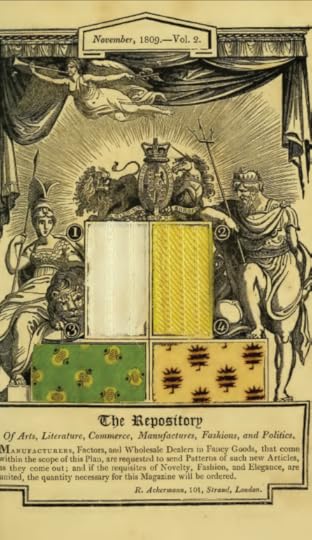Bliss Bennet's Blog, page 10
September 30, 2015
Ackermanns Fashion Plates April 1810
April 1810, and for the first time, Ackermann’s features a fashionable man! I love the rich brown (“corbeau”) of his coat, paired with the light sage breeches. Quite different from the usual black or dark blue, no? I do wonder what he is doing with that scarf, though, don’t you?
To balance him off, we have not one but three ladies in Evening and/or Opera dress. I’m quite taken with the unusual hair style of the woman seated at the front of the bench—”an eastern style, confined with a comb ornamented with pink topaz, and flowing in loose irregular curls per the bands in front” (262). Perhaps I’ll give it a try…


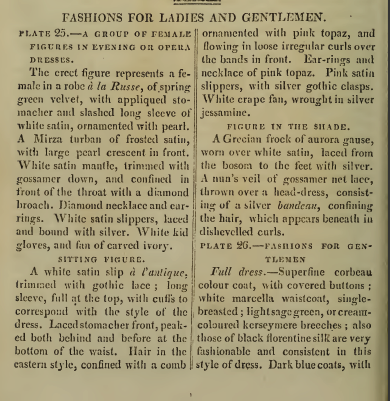

This month’s fabric selections focus on dress materials. “Rock-coral muslin” looks a bit brown to me (see #3), but I do like the pattern. I wonder if the color has faded over time?

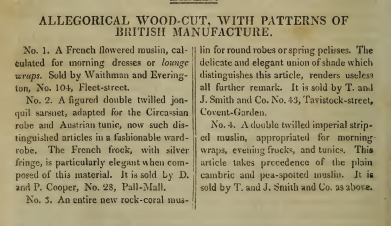
September 23, 2015
Ackermanns Fashion Plates March 1810
March 1810’s fashion plates focus again on whites: white satin for a Ball Dress; spotted white muslin for a Morning Dress. I’m struck again by how often children are shown with their mothers in the morning dress plates; is Ackermanns simply reflecting the new societal focus on the importance of motherhood? Or helping to construct it?
Arbiter Elegantiarum insists that, despite last month’s critique of women’s fashion choices, “I beg I may not be considered as exclusively censuring the foibles of the fair. No, no; the lords of the creation, with all their boasted superiority, are equally implicated.” But, despite the disclaimer, Arbiter insists that “This is not the place to register the follies and fopperies of men.” Why not, I wonder?
I do have to laugh, though, at Arbiter‘s disdain for the “monstrous tippets” being lugged around by the fashionable women of the day: “Should this wretched thing continue in use, I would strongly recommend the re-introduction of the hoop and farthingale, that the foundation may bear some proportion to the superstructure, and that our ladies may no longer have the painful appearance elf being top-heavy.” Wish we had a picture of that!
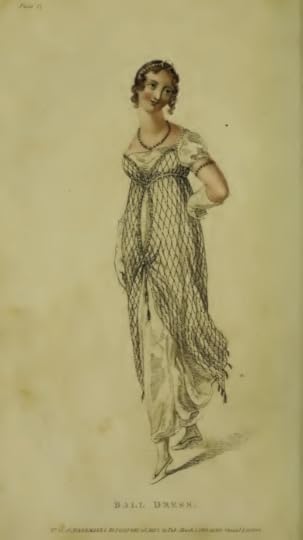

In addition to the usual fabric samples included in each issue, March’s book also features fancy paper samples, which I’ve included below. Can you imagine Regency women using them to covering boxes, screens, card-racks, and portfolios? Maybe we should all try out the paste recipe helpfully included?
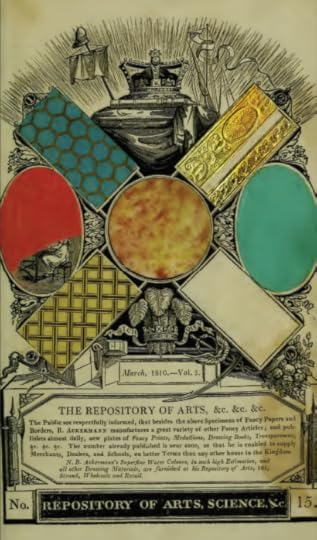
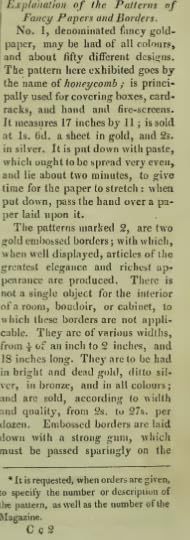


And finally, this month’s fabric samples. I can’t quite make out what the figures on #4, the “amber-shot sarsnet,” are meant to be—the ever-popular bee? A flower? Or just a geometric figure? A lovely color, no matter what the figure…
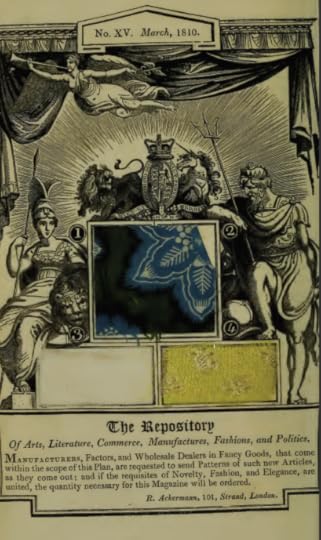

September 16, 2015
Ackermanns Fashion Plates February 1810
The word for February 1810 is swansdown. Both of our fashion plates for evening dress include cloaks “trimmed entirely around with with swansdown.” I’ve never seen a garment with swansdown trim; is swansdown as warm as fur?
Not sure why the lady in the first plate is holding an opera glass, when the label on the second plate is “Opera Dress”…
N.B. The color of the “Evening or Full Dress” in the first plate is described as purple, not black, as it appears to my eye in this print.
Arbiter Elegantiarum‘s commentary includes a lengthy report on men’s fashions this month, although sadly no pictures accompany it. We do have a reference to waistcoat colors, which mentions an “India rib patent green print,” reproduced on the fabric sample page at the back of the journal (see sample #4 below).
Arbiter‘s actual commentary, though, focuses on female dress. Fascinating to see how women’s dress can simultaneously be seen as of “indicative of easy virtue” AND “originated with some desperate prude” (123). Pretty amazing to see how Regency-era women had to toe such a narrow fashion line to avoid sexualized judgments…
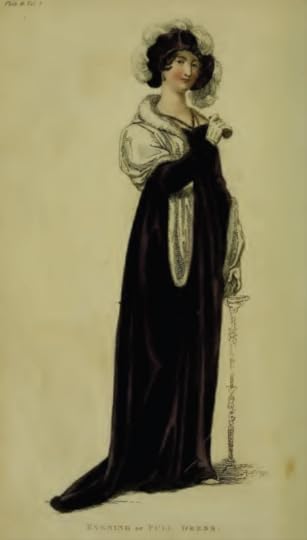
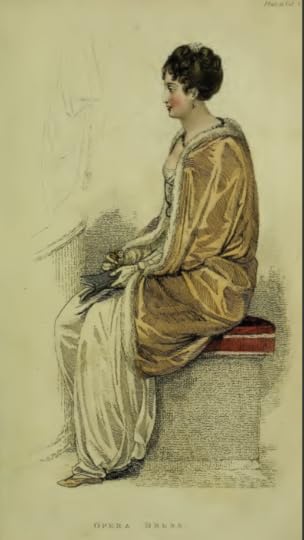

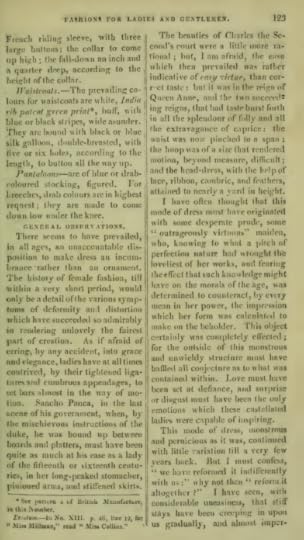
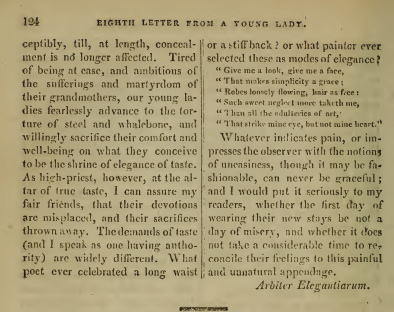
Ackermanns Repository, February 1810, Vol 1, issue 4, pages 122-24.
This month’s fabric samples include a technological innovation: “A patent has lately been obtained by Hewson, Higgins, and Ilett, for printing green on cotton goods, a discover never before offered to the public.” I rather like the little green starbursts on this sample, and can definitely picture the fabric made up as a waistcoat. Alas, this green was in all likelihood the quite toxic Scheele’s green, made from a compound of arsenic.
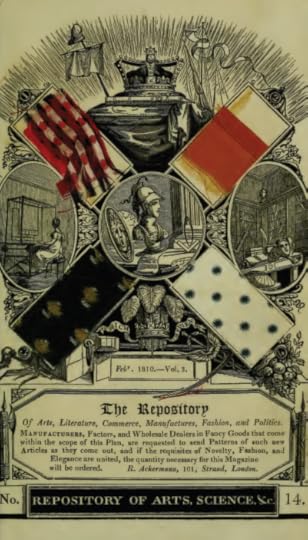

Ackermanns Repository, February 1810, Vol 1, issue 4, pages 130.
September 15, 2015
Happy Book Birthday to REBEL
Happy book birthday to me! Or really, to my first novel, A REBEL WITHOUT A ROGUE! You can purchase an e-book, or a paperback:
At amazon: http://amzn.to/1HxCK1Q
At All Romance e-books: http://bit.ly/1TFBxej
At Kobo: http://bit.ly/1Kb4Nb3
iBooks: http://apple.co/1e3kxyh
Barnes & Noble: http://bit.ly/1O0brPx
September 9, 2015
Ackermann’s Fashion Plates January 1810
The first fashion plates of the year 1810 feature an evening dress and a carriage or promenade dress. The latter is lined with “the spotted American squirrel skin,” which seems an unusual, and likely expensive, choice, if the squirrel in question is the spotted ground squirrel, one of the smallest squirrels found in North America, and one native only to Mexico and the western half of the continent. Arbiter Elegantarium suggests an alternative of leopard skin—which do you think would be more expensive?




From Ackermann’s Repository, January 1810, 1.3, pages 45-47.


This month’s fabric samples include a lovely ruby damask for furniture, and two fabrics for clothing. Unfortunately, the flowers in sample 3, which the copy reports as being “orange,” appear to have faded.
Anyone know what “mole velvet” is? After receiving a copy of Fairchild’s Dictionary of Textiles for my birthday last month, I thought I’d be able to define any fabric term for you, but unfortunately there’s no listing for “mole” or for “velvet, mole” in the 7th edition of Fairchild’s…
September 2, 2015
Ackermann’s Fashion Plates December 1809
I would have thought that fashions for wintertime might feature more color, but in December 1809, Ackermann’s featured two plates with ladies clothed in white dresses, one a “Tyrolean Walking Dress,” the other an Evening Dress. Although Arbiter Elegantiarum declares that “crimson, purple, dark green, and brown, are likely to become the prevailing colors, with borders of black, gold, or ermine; and that scarlet, that terrible destroyer of female beauty, grace, and elegance, is consigned, I hope for ever, ‘to the tomb of all the Capulets.'”
Another oddity: the walking dress is described as having an “elastic belt.” Elastic cord or string dates from the 1840s, according to the OED. But perhaps the belt is elastic in one of the word’s more general senses, “that which spontaneously resumes (after a longer or short interval) its normal bulk or shape after having been contracted, dilated, or distorted by external force” (OED, dating from 1674), or “that can be stretched without permanent alteration of size or shape” (OED references elastic corsets c. 1835). Any information on the use of elastic in fashion, I’d love to hear from you!
Plates from Ackermann’s December 1809, Vol. II, no xii, pages 402-3.




And here are this month’s fabric samples, all in shades of gold. Since several are labeled “Jubilee,” I’m guessing they were manufactured to commemorate George the III’s 50th year of rule, which was celebrated in October 1809. Sample #4 looks rather fuzzy; was this its original texture, or has the sample deteriorated over time? Pages 411-42.


August 26, 2015
Ackermann’s Fashion Plates November 1809
November 1809’s Ackermann’s fashion plates focus on Morning Dress. The first plate features another mother-child pairing, with a very Romanticized depiction of the child (just look at those rosy cheeks!). Arbiter Elegantiarum‘s advice this month focuses on suiting one’s style of dress to one’s style of figure: “I would persuade them, that the endeavour to be appear what we are not, is as erroneous in dress as in morals, and that it as invariable fails in its object” (333).
Vol. II, no. xi, pages 332-34.
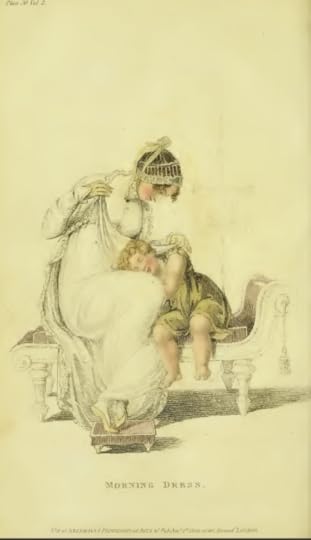
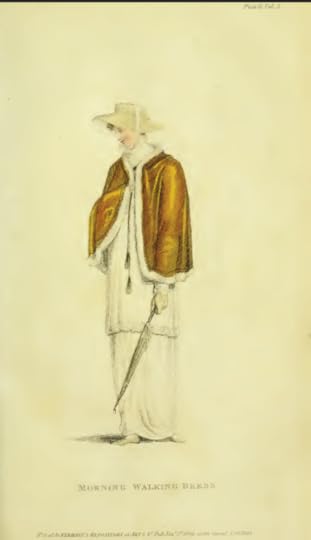



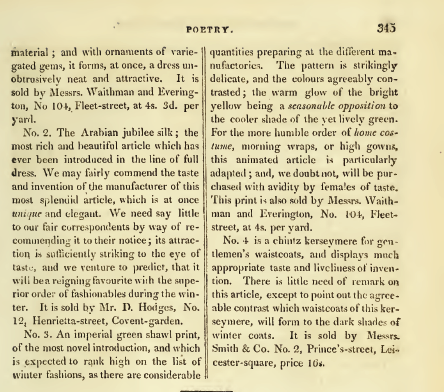
I’m really taken by this month’s fabric samples. The print on the left puts me in mind of bees, while the one on the right makes me think of those fuzzy caterpillars I used to love to touch when I was a child. I wouldn’t mind having a dress made out of either (although #4 is intended for a gentleman’s waistcoat, according to the description above…) (pages 342-43).
August 19, 2015
Ackermann’s Fashion Plates October 1809
October 1809’s fashion plates from Ackermann’s feature a blue ball dress with a very slim (and clingy) silhouette and a hem that shows off more than a bit of ankle! I wonder if any readers found it a bit scandalous? The second plate is less risqué: a white walking dress with quite a fancy (and colorful!) shawl and umbrella pairing.
Arbiter Elegantiarum‘s comments speak about suspending his/her “strictures” of late, both out of a desire to see what impact, if any, Arbiter‘s advice had had on readers, and out of hope that some readers would argue with or corroborate Arbiter‘s views. Apparently one lady has even attacked AE‘s strictures in verse! I’ll have to see if I can track this down…
Also included are fabric samples, with their relevant write-ups.
Vol. II, no. x, pages 258-59; 277.


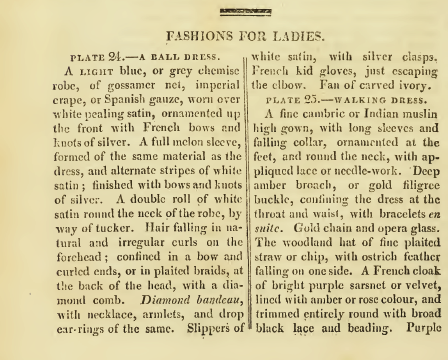



August 12, 2015
Ackermann’s Fashion Plates September 1809
Ackermann’s September 1809 fashion plates strike a somber note: the first depicts Mourning dresses for both mother and child. And while the second shows a seaside promenade dress, the sketched-in figure of a laborer on the shore suggests that life is not all fashion and play… Vol. II, no. ix, pages 192-93.
FYI, a “cestus” is defined by the OED as “A belt or girlde for the waist; particularly that worn by a bride in ancient times.” A bit ironic, to see it figure in a mourning gown design? Or commemorative, if the person mourning is a widow?




This month’s fabric samples include a snippet from one of the most colorful prints I’ve seen in the magazine. I’ve just realized that these fabric samples are also accompanied by write-ups, which I’ve not included before. I’ll have to go back and emend my earlier posts. Unfortunately, the write-up tells me that this colorful print is intended for use in furniture or draperies, not for dresses… Vol. II, no. ix, page 206:

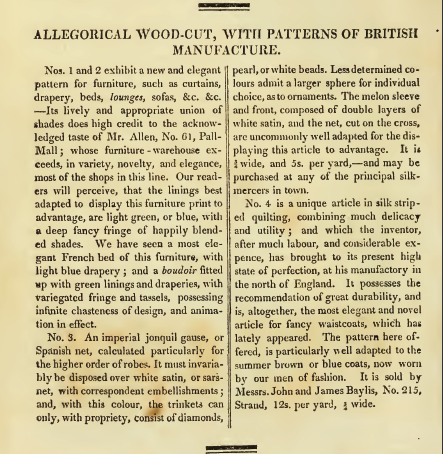
August 5, 2015
Ackermann’s Repository Fashion Plates: August 1809
Ackermann’s fashion plates for August of 1809 (vol II, issue ii, pages 48-49) feature Walking Costumes (including one for a child) and Promenade Dresses—all the fashionable are out taking their exercise, it seems! And another page of fabric samples…







